1980 SKODA 120 LSE weight
[x] Cancel search: weightPage 24 of 238
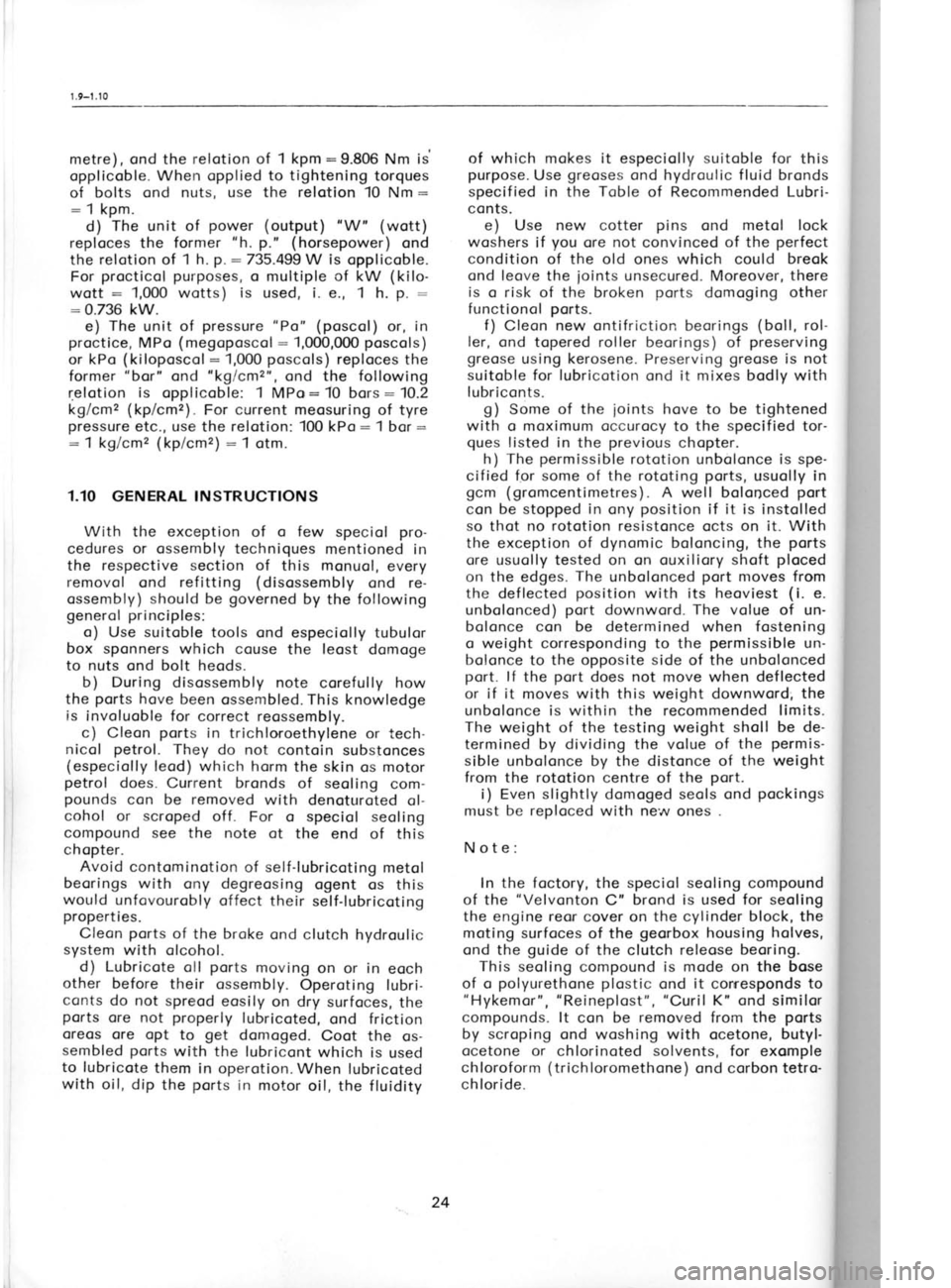
metre), ond the
relotion of 1
kpm :9.806
Nm is'
opplicoble. When opplied to tightening
torques
of bolts ond nuts, use the relotion
10 Nm :
: 1 kpm.
d) The unit of power (output) tW'
(wott)
reploces the former "h.p."
(horsepower) ond
the relotion
of t h. p.:
735.499 W is opplicoble.
For procticol purposes,
o multiple of kW (kilo-
wott :
1,000 wotts) is used, i. e., t h. p. :
:0.736 kW.
e) The
unit of pressure "Po"
(poscol) or, in
proctice, MPo (megoposcol :
1,000,000 poscols)
or kPo (kiloposcol :
1,000 poscols)
reploces the
former "bor"
ond "kglcmz",
ond the following
relation is opplicoble: 1 MPo: 10 bors :1O.2
kg/cm2 (kp/cm2).
For current meosuring
of tyre
pressure etc., use the relotion: 100 kPo :
1 bor:
:1kglcm2 (kp/cm,) :1
otm.
1.10 GENERAL INSTRUCTIONS
With the exception of o few
speciol pro-
cedures or ossembly techniques
mentioned in
the respective section of
this monuol,
every
removol ond refitting (disossembly
ond re-
ossembly) should be governed
by the following
generol principles:
o) Use suitoble tools ond especiolly tubulor
box sponners which couse the leost domoge
to nuts ond bolt heods.
b) During disossembly note corefully how
the ports
hove been ossembled. This knowledge
is involuoble for correct reossembly.
c) Cleon ports
in trichloroethylene or tech-
nicol petrol.
They do not contoin substonces
(esoeciolly leod) which horm
the skin os motor
petrol does. Current bronds of seoling com-
pounds con be removed with denoturoted
ol-
cohol or scroped off. For o speciol
seoling
compound see the note ot the end of this
chopter.
Avoid contominotion of self-lubricoting
metol
beorings with ony degreosing
ogent os this
would unfovourobly offect their self-lubricoting
properties.
Cleon ports
of the broke ond clutch hydroulic
system with olcohor.
d) Lubricote
oll ports
moving on or in
eoch
other before their ossembly. Operoting lubri-
conts do not spreod eosily on dry surfoces,
the
ports ore not properly
lubricoted, ond friction
oreos ore opt to get
domoged. Coot the os-
sembled ports with the lubricont which is used
to lubricote them in operotion. When lubricoted
with oil, dip
the ports
in motor oil, the f luidity of which mokes
it
especiolly suitoble for
this
purpose. Use greoses
ond hydroulic f luid bronds
specified in the Toble
of Recommended Lubri-
conts.
e) Use new cotter pins
ond metol lock
woshers if you
ore not convinced of the perfect
condition of the old ones which could breok
ond leove the joints
unsecured. Moreover, there
is o risk
of the broken ports
domoging other
functionol ports.
f) Cleon new ontifriction beorings (boll,
rol-
ler, ond topered roller beorings) of preserving
greose using kerosene.
Preserving greose is not
suitoble for lubricotion ond it mixes bodly with
I ubriconts.
g) Some of the joints
hove to be tightened
with o moximum occurocy to the specified
tor-
ques listed in the previous
chopter.
h ) 'Ihe
permissible rototion unbolonce is spe-
cified for some of
the rototing ports,
usuolly in
gcm (gromcentimetres). A well boloqced port
con be stopped in
ony position
if it is
instolled
so thot no rototion resistonce
octs on it. With
the exception of dynomic boloncing, the ports
ore usuolly tested on on ouxiliory shoft ploced
on the
edges. The
unbolonced port
moves from
the deflected position
with its heoviest (i.
e.
unbolonced) port
downword. The
volue of un-
bolonce con be determined
when fostening
o weight corresponding to the permissible
un-
bolonce to the opposite side
of the unbolonced
port. lf the port
does not move when deflected
or if it moves with this weight downword; the
unbolonce is within the recommended limits.
The weight of the testing weight sholl be
de-
termined by dividing the volue of the permis-
sible unbolonce by the distonce of the weight
from the rototion
centre of the port.
i) Even slightly domoged seols ond pockings
must be reploced with new ones
Note: In the foctory,
the speciol seoling
compound
of the "Velvonton
C" brond is used for seoling
the engine reor
cover on the cylinder block, the
moting surfoces of the georbox housing holves,
ond the guide
of the clutch releose beoring.
This seoling compound is mode
on the bose
of o polyurethone
plostic ond it
corresponds to
"Hykemor", "Reineplost", "Curil
K" ond similor
compounds. lt con be removed from the ports
by scroping ond woshing with ocetone, butyl-
ocetone or chlorinoted solvents, for exomple
chloroform (trichloromethone)
ond corbon tetro-
ch loride.
24
Page 44 of 238
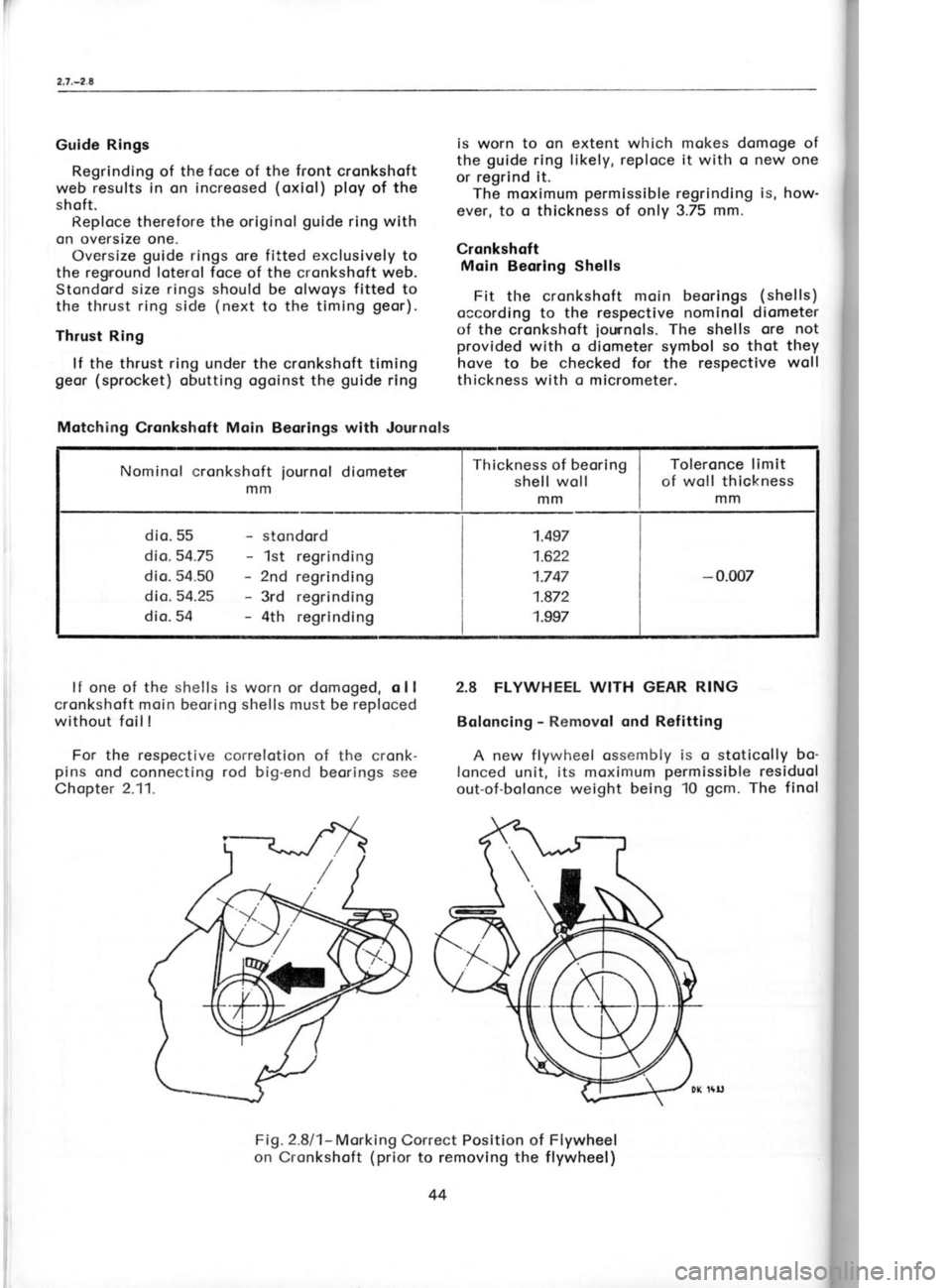
2.7.-2.8
Guide Rings Regrinding of the foce of the front
cronkshoft
web results in
on increosed (oxiol) ploy
of the
shoft. Reploce therefore the originol guide
ring with
on oversize one. Oversize guide
rings ore fitted exclusively
to
the regrround loterol
foce of the cronkshoft web.
Stondord size rings
should be olwoys fitted
to
the thrust ring side (next
to the timing geor).
Thrust Ring
lf the thrust ring under the cronkshoft timing
geor (sprocket)
obutting ogoinst the guide
ring is worn to on
extent
which mokes domoge of
the guide
ring likely, reploce it
with o new one
or regrind it.
The moximum permissible
regrinding is, how-
ever, to o thickness of only 3.75 mm.
Cronkshoft Moin Beoring Shells
Fit the cronkshoft moin beorings (shells)
occording to the respective nominol diometer
of the cronkshoft
iounnols. The shells
ore not
provided with o diometer symbol so thot they
hove to be checked for
the respective woll
thickness with o micrometer.
2.8 FLYWHEEL WITH GEAR RING
Boloncing -
Removol ond Refitting
A new flywheel ossembly is o
stoticolly bo-
lonced unit, its moximum permissible residuol
out-of-bolonce weight being '10
gcm. The finol
lf one of the
shells
is worn or domoged, o ll
cronkshoft moin beoring shells must be reploced without foil !
For the respective correlotion of the cronk-
pins ond connecting rod
big-end beorings see
Chopter 2.11. dynomi<
ism shr
sembfed
Thus
sitioq of
shoft be
from o
1
When
rnork on
zero line
ond prol
mork op
cylinder
the rem<
gcm sin
mosses (
concentr
cronksho
holes rot
wheel ir
interf erel
For thi
on the r
sition, i.
cronksho
fore the
When
one or wl
follows:
1. Fit .
residuol o
olly offec
2. The
bolonce r
hos o hig
correctior
once. lt
occording
porogroph
Chopter 1
bending t
To Reploc
Reploce
worn or d,
ring, toke
the interfr
sion). The
prime impr
ossembly
storter mo
The gec
removed b
port pod
cr
MP 1-153. I
ing the ge
it off. The
monufoctut
When ur
front foce
ond drill
o
Fig.2.8l1- Morking
Correct Position of
on Cronkshoft (prior
to removing theFlywheel
f lywheel)
Motching
Cronkshoft Main Beorings with Journols
Nominol cronkshoft mmiournol
diometer Thickness
of beoring
shell woll
mm Toleronce limit
of woll thickness
mm
dio. 55 dio.54.75
dio. 54.50 dio.54.25
dio. 54 stondord
1st regrinding
2nd regrinding
3rd regrinding
4th regrinding 1.497
1.622
1.747
1.872
1.997
-
0.007
44
Page 48 of 238
![SKODA 120 LSE 1980 Workshop Manual Nominol
diometer
mm Gudgeon
pin
diometer mIn Pin
bore
in piston
nl
n] Connecting
rod
smoll-end bore
(br-rsh diometer)
mm
20
20.0s 20
-
0.003
20.0s --
0.003 -
0.004
zu - o.o1o
,o 05, 3 3 SKODA 120 LSE 1980 Workshop Manual Nominol
diometer
mm Gudgeon
pin
diometer mIn Pin
bore
in piston
nl
n] Connecting
rod
smoll-end bore
(br-rsh diometer)
mm
20
20.0s 20
-
0.003
20.0s --
0.003 -
0.004
zu - o.o1o
,o 05, 3 3](/manual-img/3/57425/w960_57425-47.png)
Nominol
diometer
mm Gudgeon
pin
diometer mIn Pin
bore
in piston
nl
n] Connecting
rod
smoll-end bore
(br-rsh diometer)
mm
20
20.0s 20
-
0.003
20.0s --
0.003 -
0.004
zu - o.o1o
,o 05, 3 3?3 2a
13 33?
,o os
13
33?
Toble
ofMotching GudgeonPins
to Pistons ond
Smoll'end Bushes The
cler
should be
cleoronce
the rings
2.11 COn
The con
o brorrze
b
beoring sh
in the big
Before r
for compli<
weight, ol
ond motch
shoft.
For its
<
ter 2.12.
To Check
Connecti
weight gror
foctory, ligl
yellow poi
Should the
during stor
been fitted
determ ined
remove o c
smoll ond t
the smoll
r
in the
engi
(+2 gr.).
When re
odjust its w
connecting
DK 63:
Fig
'l - boloncing
2 -
numericol
GUDGEON
PIN
Tlre gr-rdgeon pin
is cr slight interference f it in
the piston-
lts cleoronce in the
connecting rod
smoll-end bush is:;pecified in
the Chopter
"Connecting Rocl ".
The steel gudgeon pin
is lrollow ond hos
c rronrinol cl iometer of 20 ntnr,
replocement pitts
l.rovirrg; o nominol dionreter of
20.05 mnr. When
f itting on oversize gudgeon
pin with 20.05 mm
nomincl diometer, the bore
toking the pin must
be reomed to dimerrsions
specif ied irr the re-
spective l-oble.
PISTON RINGS
To ensure their correct function, they must
be f itted in the correct position, they
must hove
no or onlv c minimum cleoronce clong
their
r:ircumference, o smqll
cleoronce in
the gops'
ond tlrey mLrst rrove freely in the piston
grooves.
DK 1436
Fig.2.1Ol3 .-
Seqerence ond
[Jlethod ot Fitlingl
Piston Rings
( Mork Positioning).
Fronr top to bottom: chromium-ploted compres-
sior.r rinq, bevelied compression ring,
spring
locrded exponding oil control ring
Fit the {irst ring in cny orbitrory position
(its cylindricol chromium-ploted peripherol
port
is chomfered on either side,
focilitoting identi-
f icotion), the second, bevelled ring with
the
lettering 'TOP"
or onother mork
on top, ond
llre oil lontrol ring with its
outer shorp
edge g>ointirig
dowtrword. lf
tl-rere is
ony doubt os
to
the coriect selection of
the rings, check them
for proper seoling in
the cyli.nder.before os-
rurbty. ltrsert tlre ring into
the cylinder ond
level it by pLrshing
home the piston heod' In
the cose of
o used cylinder, insert
the ring
obout 20 ntin
below the
top edge of the cylinder
lirrer, i. e.
o plcce rvhere the
cylinder. liner
is
olreodv worn, while checking for
the right
clecronce in the piston
groove ond for the
correct gcrp in the
cYlinder bore.
For ri"ngs
thot hove not
been run-in,
the
fol'
lowirrg circumferentiol gop or
contoct cleoronce
with rlgord to
the cvlinder liner
is permissible:
none foi the chromir-rm-ploted compression
ring,
two in c totol ronge
of on ongle of
35 degr' for
the bevellecl compression ring
ond the oil
control ring. Lcrger
contcct cleoronces olong
the circumTerence denote
either on
incorrect
selection of
the ring, for exomple the
ring
does
not correspond to
the cylinder bore, or
on
excessive weor
of the cylinder liner.
Check the ring gop cleorcnce using
feeler
goLrges- For new
compressiol
lngs, this
gop
.leo"ronc" should
be
0.25 to 0.40 ntm, for
new
oil corrtrol rings
0.20 to 0.35 nrnr. The
nloxinrtlttt
oernrissible cleoronce
of
worn rings is 1mm'
48
105 r20
'.;iA
'!.t l
\Lt { .,
x),:=
s!-9
f:ig.2.1A14 -
Checkinq Pi.;ton Ring
Gop
Page 50 of 238
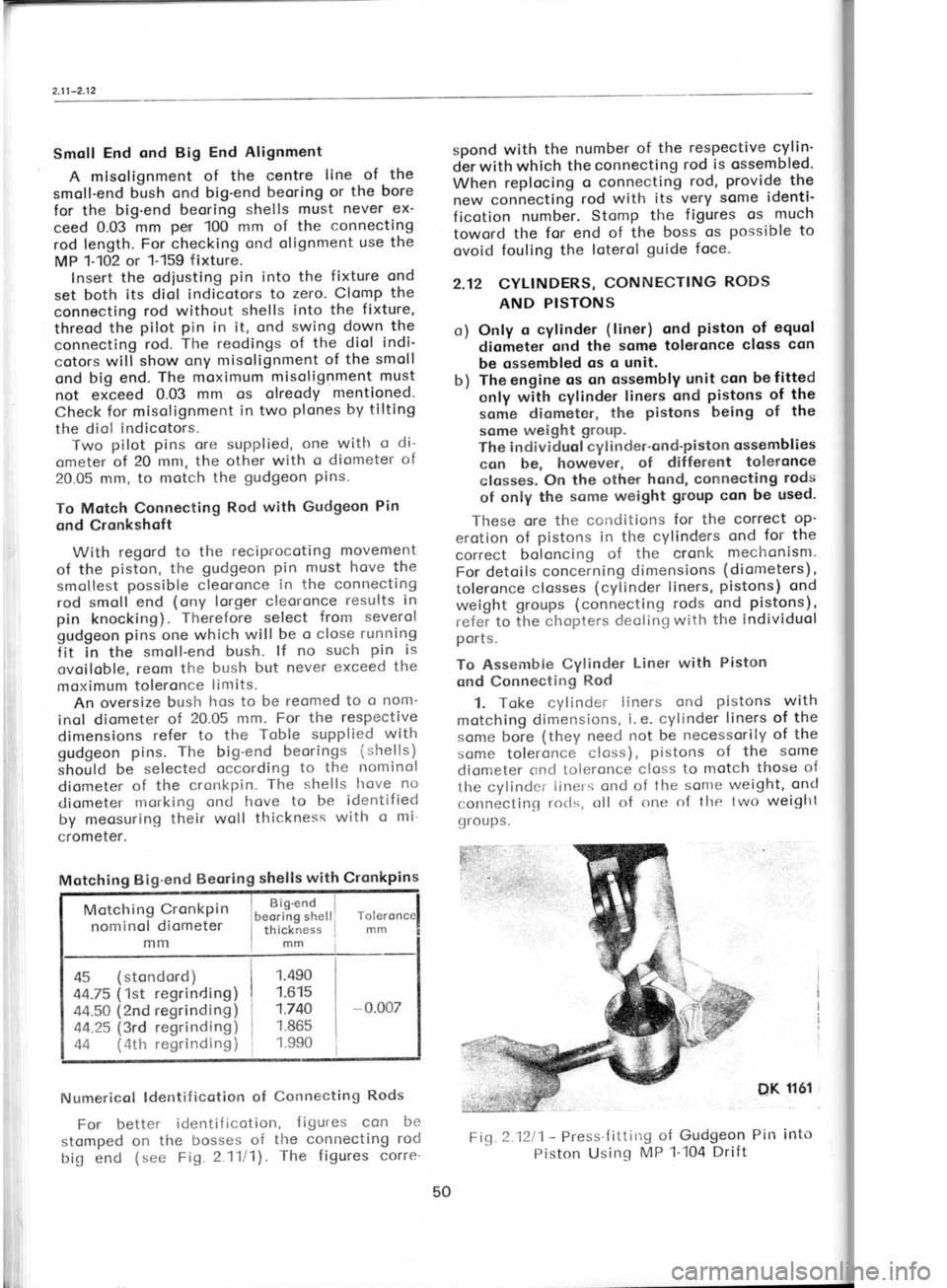
{
Smoll End ond
Big End Alignment
A misolignment of the centre line
of the
smoll-end bush ond big-end beoring
or the bore
for the big-end
beoring shells must never ex-
ceed 0.03
mm per 'lO0
mm of the connecting
rod length. For checking
ond olignment use
the
MP 1-102 or 1-159 f ixture.
Insert the odiusting pin
into the fixture ond
set both its diol indicotors to
zero. Clomp the
connecting rod without shells
into the fixture,
threod the pilot
pin
in it, ond swing
down the
connecting rod. The recdings
of the diol indi-
cotors will
show ony misolignment of the
smoll
ond big end. The moximum misolignment must
not exceed 0.03
mm os olreody mentioned.
Check for misolignment in two plones by tilting
the diol indicotors.
Two pilot
pins ore supplied, one with o
di-
ometer of 20 rnnr. the
other with o diometer of
20.05 mm, to motch the gudgeon
Pins.
To Motch Connecting Rod
with Gudgeon Pin
ond Cronkshoft
With regord to the reciprocoting movement
of the piston,
the gudgeon pin must hove
the
smollest possible
cleoronce in the
connecting
rod small end (ony lorger cleorcnce results
in
pin knocking). Therefore
select from
severol
gudgeon pins
one which will
be o close running
fit in the smoll-end
bush. lf no suclr pin is
ovoiloble, reom
tlre bush but never exceed the
moximum toleronce limits.
An oversize buslr lros to be
reomed to o nom-
inol diometer of 20.05 mm. For
the respective
dimensions refer to
the Toble supplied with
gudgeon pins. The big"end
beorings
i:;hells)
inouta be
selected occording to the nominol
diometer of the cronkpin. The
shells lrove no
diometer ntorking
oncl hove to be identif !ed
by meosuring their woll thickness with o mi'
crometer.
Motching Big-end Beoring
shells
with Cronkpins
MotchingCronkpin o"|,,n"iifl",,l ro,u,on
nominol diometer
1 thick"ness
mm
mm mm
45 (stondord)
44.75 (1st
regrinding)
44.50 (2nd
regrinding)
44.25 (3rd regrinding)
44 {:lttr regrinding) 1.490
1.615
1.740
1.865
1 990 0.007
Numericol lderrtif icotion of
Connecting Rods
For better identificotion, {igures con
be
stomped on the bosses of
the connecting rod
big end ( see Fig 2 11
1) . The f igures corre-spond with
the
number of the respective
gVtin-
derwithwhich theconnecting rod
is ossembled.
When replocing o connecting rod,
provide the
new connecting rod
with its very some identi-
ficction numbel. Stomp
the figures os much
toword the for end of the boss os possible to
ovoid fouling the loterol guide foce.
2.12 CYLINDERS, CONNECTING RODS
AND PISTONS
o) Only o cylinder (liner)
ond piston of
equot
'
diometer ond the some toleronce closs con
be ossembled qs
s unit.
b) Theengine cs qn
ossembly unit con befitted
cnly with cylinder liners ond pistons
of the
some diometer, the pistons being
of the
some weight grnLtp.
The inclividuol cylinder'cnd-piston qssemblies
con be, however, of dif
ferent toleronce
closses. On the othe'r hond, connecting rods
of only the sqme weight group
con be used-
These ore the cc;tditions for
the correct op-
erotion of pistons in the
cylinders ond for the
correct boloncing of the cronk mechonism.
For detoils concerning dimensions (diometers),
toleronce closses (cylinder liners, pistons) ond
weight groups
(connecting rods ond pistons)'
refei to fhe chcpters deoling with
the
individuol
pc|rts"
To Assembie Cylinder Liner
with Piston
qnd Connectirrg Rod
1. Toke cylinder liners ond pistons with
motching dinrensions, i. e.
cylinder liners of the
some boie (they need
not be necessorily of the
scrme toleronce closs), pistons
of the some
cliometer <,nrl tcieronce closs
to motch those of
the cvlinclr:i iitrers
ond of the sonre weight, oncl
connectitrct rorls,
tlle twtl weiglrt
cl roLr PS.
lti''
DK 1161 2.
1
OCCorl Selec'
cyl i nd
tolpro
the (
motch Son
pin or
gudge
in wh
suitob
bush.
Mor
respor
with v
meric<
Rod'.
3.L
the gr-
80"c i Sme
home
some
threod
Pin, o
circlip
on thr
pressi I
Fit
hole ir
the orr
4.F
or exp
detoils
the ri
groove
5- Pr
the crc
ond co
2.13 I
In or
ter ist ic
coms o
comsh<
c leoror
the cor
Volve '
with
lntoker
open be
close o
Fi,c 2.1211 -
Press'f ittirrg
of Gudgeon Pin into
Piston Usinq MP 1-i04
Drift
50
Page 60 of 238
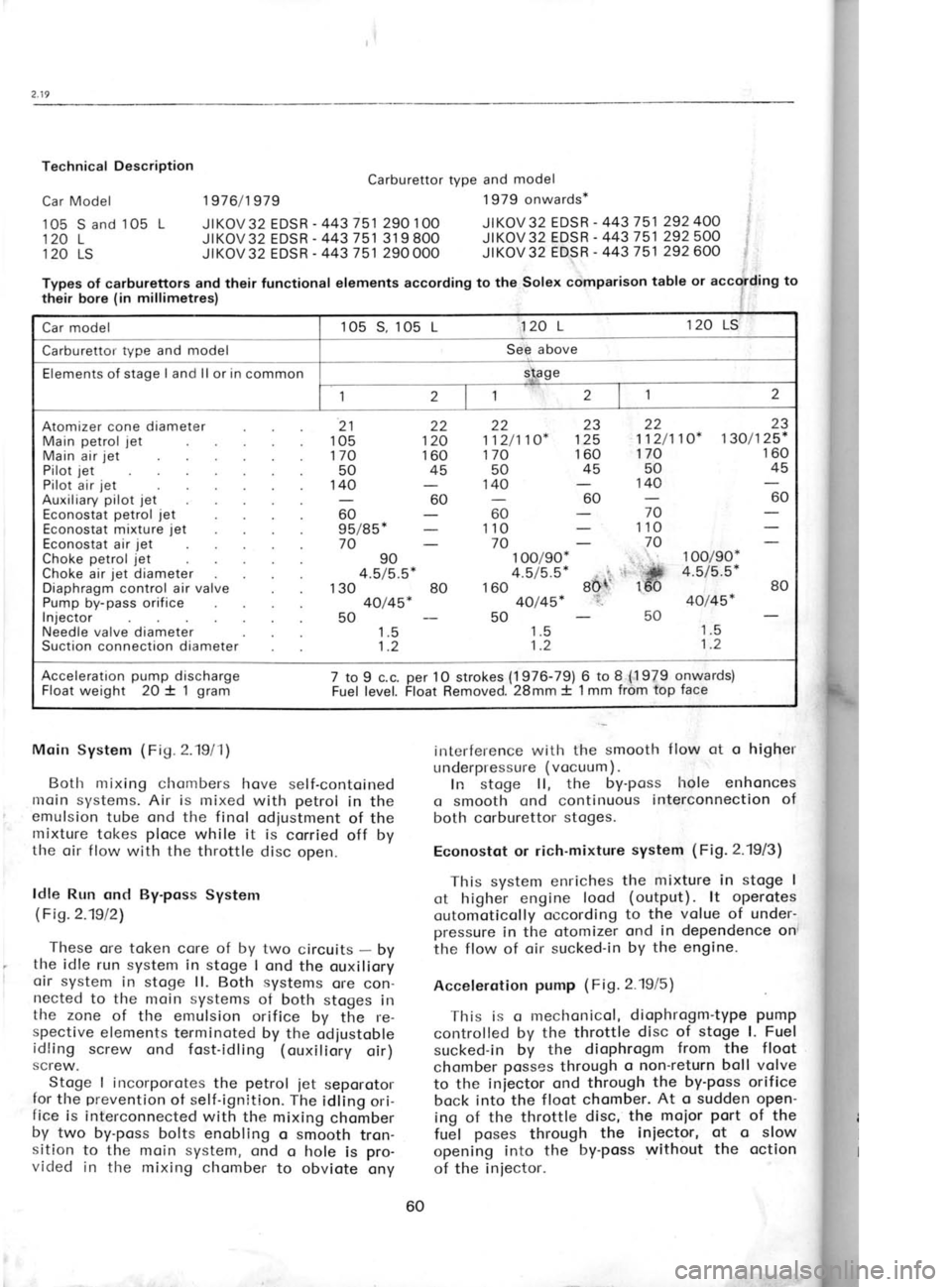
Technical
Description
Car Model 1976/1979 Carburettor type
and model
1979 onwards*
105
120 120 S
and 105 L
L
LS
Types of carburettors and
their functional elements according to
the,polex cdnparison table
or
their bore (in
millimetres) JlKOV32 EDSR
-
443751 290 1
00 JlKOV32 EDSR -
443751 292400
JrKOV32 EDSR -
443751 31 9 800 JlKOV32 EDSR -
443751 292500
J|KOV32 EDSR -
443751290000 J|KOVg2 EnFF -
443751 292600
to
;1
Car model 105S, 1O5L
itZOr- '
l2OLs:
Carburettor type and model Se.B
above
Elements of stage I and ll or in
common
Fge
1 2
1
2
t
2
Atomizer cone diameter
Main petrol jet
Main air jet
Pilot jet
Pilot air jet
Auxiliary pilot jet
Econostat petrol jet
Econostat mixture jet
Econostat air jet
Choke petrol jet
Choke air jet
diameter
Diaphragm control air valve
Pump by-pass orifice
Injector
Needle valve diameter
Suction connection diameter 21
105 170
50
140
60
95/85'70
90
4.5/5.5*
130 40/45*
50 1.5
1.2 22
1 12/1 10*
170 50
140
60
110
70 1 00/90*
4.5/5.5'
160 40/45*
50 22
23
'.112/110*
130/125*
170 50
140
1Orygo*
4.5/5.s*
.80
40/45*
22
120
160 45
1.5
1.2
1,5
1.2 23
125
160 45 160
45
60
Jo
70
1'to
70
50
Jo
*erF
or"fs?
,.w'1'
80
Acceleration pump
discharge
Float weight 2O t 1 gram 7 to 9 c.c.
per
1O strokes (1976-79)
6 to 8.$19f9 onwards)
Fuel level. Float Removed.'28mm t'1mm frEm bp
face
Moin System (Fig.
2.1gl1l
Both mixing chombers hove self-contoined
moin systems. Air is mixed with petrol
in the
emulsion tube ond the finol odiustment
of the
mixture tokes ploce
while it is corried off by
the oir flow with the throttle disc open.
ldle Run ond By-poss System
(Fis.2.19l2l
These ore token core of by two
circuits -
by
the idle run system in stoge I ond the ouxiliory
oir system in stoge ll. Both systems
ore con-
nected to the moin systems
of both stoges in
the zone
of the emulsion orifice
by the re-
spective elements terminoted by the odiustoble
idling screw ond fost-idling (ouxiltory
oir)
screw.
- Stoge
I incorporotes
the petrol
iet seporotor
for the prevention
of self-ignition. The
idling ori-
fice is interconnected with the mixing
chomber
by two by-poss bolts enobling
c smboth tron-
sition to the moin system,
ond o hole is pro-
vided in the mixing chomber to obviote
onyinterference
with the smooth flow ot o hlgtler
underpressure (vocuum).
.
ln stoge ll, the by-poss hole enhonces
o smooth ond continuous intgrconnection
of
both corburettor stoges.
Econostot or rich-mixture syste4
(Fig. 2.19/3)
This system enriches the
mixture in stoge I
ot higher engine lood (output).
lt operotes
outomoticolly occording to the
volue of under',
pressure in the otomizer ond
in dependence onf
the flow of oir sucked-in by
the engine.
Accelerqtion pumP
(Fig. 2.19i5)
This is o mechonicol, diophrogm-type
PumP
controlled by the throttle disc of
stoge
l. Fuel
sucked-in by the diophrogm from the floot
chomber posses
through o non'return boll
volve
to the iniector ond through the
by'poss orifice
bock into the floot chomber. At o sudden open-
ing of the throttle disc,
the moior part
of the
fuel poses
through the
iniector, ot
o slow
opening into the by-poss
without the oction
of the iniector.
60
Page 117 of 238

5. Turning force
of box and column only. The
maximum permitted
turning force of the box and
column only (drag
link
attached to steering box
but allowed to slide freely
across idler) is 1.2kg
2.5lbs when test is carried out as in (2).
lf the force
is excessive, lubricate
universal joints
and check
thatthe drag link assembly is free to move. Repeat
test. lf still excessive remove
the steering box,
which can be removed
with the track rod still
attached.
TIME ALLOWANCE 5 mins.
6. Turning force to rotate
Steering Box input
shaft. With some form
of coupling (coupling from
'S'
type Steering Box) test the force required to
rotate the shaft; maximum prmitted
torque0.1 6kg
1.16ft lbs.
lf using an arm and spring balance as
shown the maximum force required
can be
calculated bv
160
arm length
in crn
arm length
in inches
These tests should be carried out with the
worm in the central position.
The initial force will
be 0.25 kg %lb greater
than the average pull-
force. lf excessive, remove
input shaft top bearing
cap and adjust the
bearing to give
0.OO to
0.05mm preload.
Shim Part No. 11O-509650
Steel O.3mm
1 10-59O90O Paoer
O.2mm
1 10-590902 Paper
O.7mm
Refit the shims and gaskets
and retaining cap,
fit the rubber sealing ring
dipped in oil and f it the
thin dust cover. lf the dust cover seems strained,
install a paper
gasket
between the cap and dust
cover. Part No. 1 1O-5909O0.
Retest for torque
and check rocker
shaft end
float which should be between
O.4 and O.5mm. lf
excessive and unable to adjust by the adjusting
bolt, replace steering box after contacting
the
Service Department.
Reassemble car and check the maxtmum
permitted force at the
spoke is 2.4kg 4.5lbs.
Check that the wheel
and indicator switch is
ce ntra lised.
Rocker Shaft Nut Torque
100Nm (71
lb ft).
TIME ALLOWANCE
7O mins. (inctudes
cost of additional shims)
7. Other points
which can adversely
affect the
turning force of the
Steering mechanism:
a) excessive tension
of the ball joints.
b) Workshop
Manual 7.5.5. excessive tenston
of the drag link
arms. The force required to
move the arm should be approximately 2kg or e.g.
wrth length
of arm
6 inches
max.
permitted force
equals 1.16 x 12
6
= 2.32lbs
DUST
COVER
4.6lbs when applied to the inboard
end of the
threaded portion.
TIME ALLOWANCE -
Off Vehicte 1O mins.
lf problems
are experienced
with wheel
vibration on the front
axle it is necessary to check
the amount of weight applied to one half of the
wheel rim which should not exceed
50 grams.
You are reminded
that check A1, kingpin
adjustment, is required
to be carried ogt at each of
the six and 12,0OO mile services.
1.16 x12
UST
I
ADJ
UT LENGTH
OF ARM
118 2KG
{4.6lbs)
Page 141 of 238
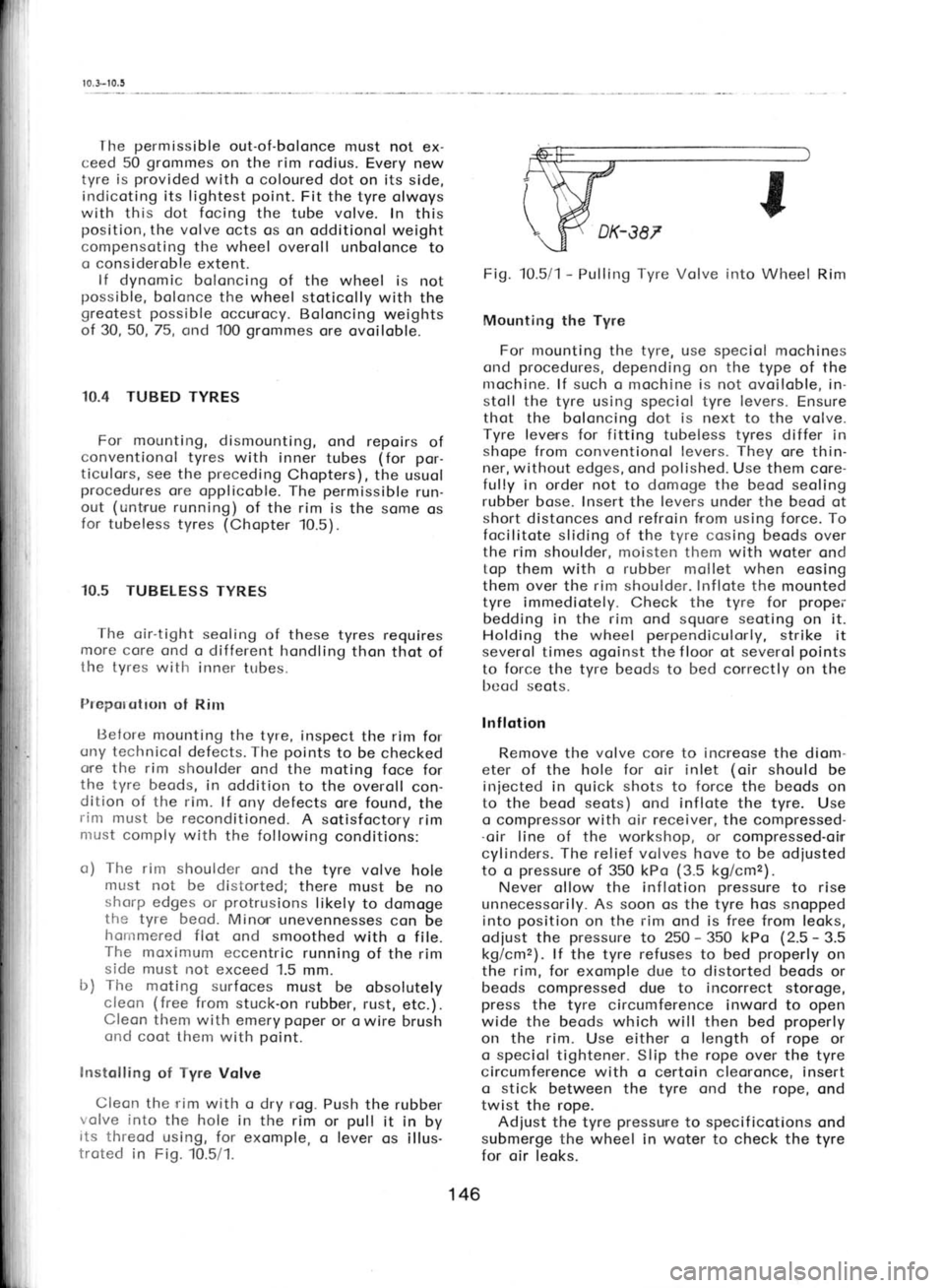
r 0.3-t0,5
Ihe permissible
out-of-bolonce must not ex-
ceed 50 grommes
on the rim rodius. Every new
tyre is provided
with o coloured dot on its side,
indicoting its lightest point.
Fit the tyre olwoys
with this dot focing
the tube volve.
ln this
position, the volve octs os on odditionol weight
compensoting the wheel overoll unbolonce to
o consideroble extent.
lf dynomic boloncing of the wheel is not
possible, bolonce the wheel stoticolly with the
greotest possible qssuroc|.
Boloncing weights
of 30, 50, 75,
ond 100 grommes
ore ovoiloble.
10.4 TUBED TYRES
For mounting,
dismounting,
ond repoirs of
conventionol tyres with inner tubes (for
por-
ticulors, see the preceding
Chopters), the usuol
procedures ore opplicoble. The permissible run-
out (untrue
running)
of the rim is the some os
for tubeless tyres (Chopter
10.5).
10.5 TUBELESS TYRES
The oir-tight seoling of these tyres requires
more core ond o different hondling thon thot of
the tyres with inner
tubes.
Preporotlon of Rirrr
13elore mounting the tyre, inspect the rim for
ony technicol defects. The points
to be checked
ore the rim shoulder ond the moting foce for
the tyre beods,
in oddition to the overoll con-
dition of the rim. lf ony defects ore found, the
rim must be reconditioned.
A sotisfoctory rim
nrust comply with the following conditions:
o) The
rim shoulder ond the tyre volve hole
must not be distorted;
there must be no
shcrp edges or protrusions
likely to domoge
the tyre beod. Minor unevennesses
con be
hornmered flot ond smoothed
with o file.
The moximum eccentric running
of the rim
side must not exceed 1.5 mm.
b) The moting surfoces
must be obsolutely
cleon (free
from stuck-on rubber, rust,
etc.).
Cleon them with emery poper
or o wire brush
ond coot them with point.
lnstolling of Tyre
Volve
Cleon the rim with o dry rog. Push
the rubber
volve into
the hole in the rim
or pull
it in
by
its threod using, for exomple,
o lever
os illus-
troted in Fig. 10.5/1. Fig. 10.5/1
-
Pulling Tyre Volve
irrto Wheel Rim
Mounting the Tyre
For mounting the tyre, use speciol mochines
ond procedures,
depending on the type of the
nrochine. lf such o mochine is not ovoiloble, in-
stoll the tyre using speciol tyre levers.
Ensure
thot the boloncing dot is next to the volve.
Tyre leverrs for fitting tubeless tyres
differ in
shope from conventionol levers. They
ore thin-
ner, without edges, ond polished.
Use them core-
fully in order not to domoge the
beod seoling
rubber bose. Insert the levers
under the beod
ot
short distonces ond refroin from using force. To
focilitote sliding of the tyre cosing beods over
the rim shoulder, moisten them with woter ond
top them with o rubber
mollet when eosing
them over the rim shoulder. Inflote
the mounted
tyre immediotely. Check the tyre for propei'
bedding in the rim ond
squore seoting
on it.
Holding the wheel perpendiculorly,
strike it
severol times ogoinst the f loor ot severol points
to force the tyre beods
to bed
correctly on the
bcad seots.
lnf lotion
Remove the volve
core to increose
the diom-
eter of the hole for oir inlet (oir
should be
iniected in quick
shots to force
the beods
on
to the beod seots) ond inflote the tyre. Use
o compressor with oir receiver, the
compressed-
.oir line of the
workshop, or
compressed-oirr
cylinders. The relief volves hove to be odiusted
to o pressure
of 350 kPo (3.5
kg/cmz).
Never ollow the inflotion pressure
to rise
unnecessorily. As soon os the tyre hos snopped
into position
on the rim
ond is free from leoks,
odiust the pressure
to 250 -
350 kPo (2.5 -
3.5
kg/cmz). lf the tyre refuses to
bed properly
on
the rim,
for exomple due to distorted beods or
beods compressed due to incorrect storoge,
press the tyre circumference inword to open
wide the beods which will then bed properly
on the rim. Use either o length of
rope or
o speciol tightener. Slip the rope over the
tyre
circumference with o certoin cleoronce, insert
o stick
between the tyre ond the rope, ond
twist the rope.
Adiust the tyre pressure
to specif
icotions ond
submerge the wheel in woter to check the
tyre
for oir leoks.
146
Page 173 of 238
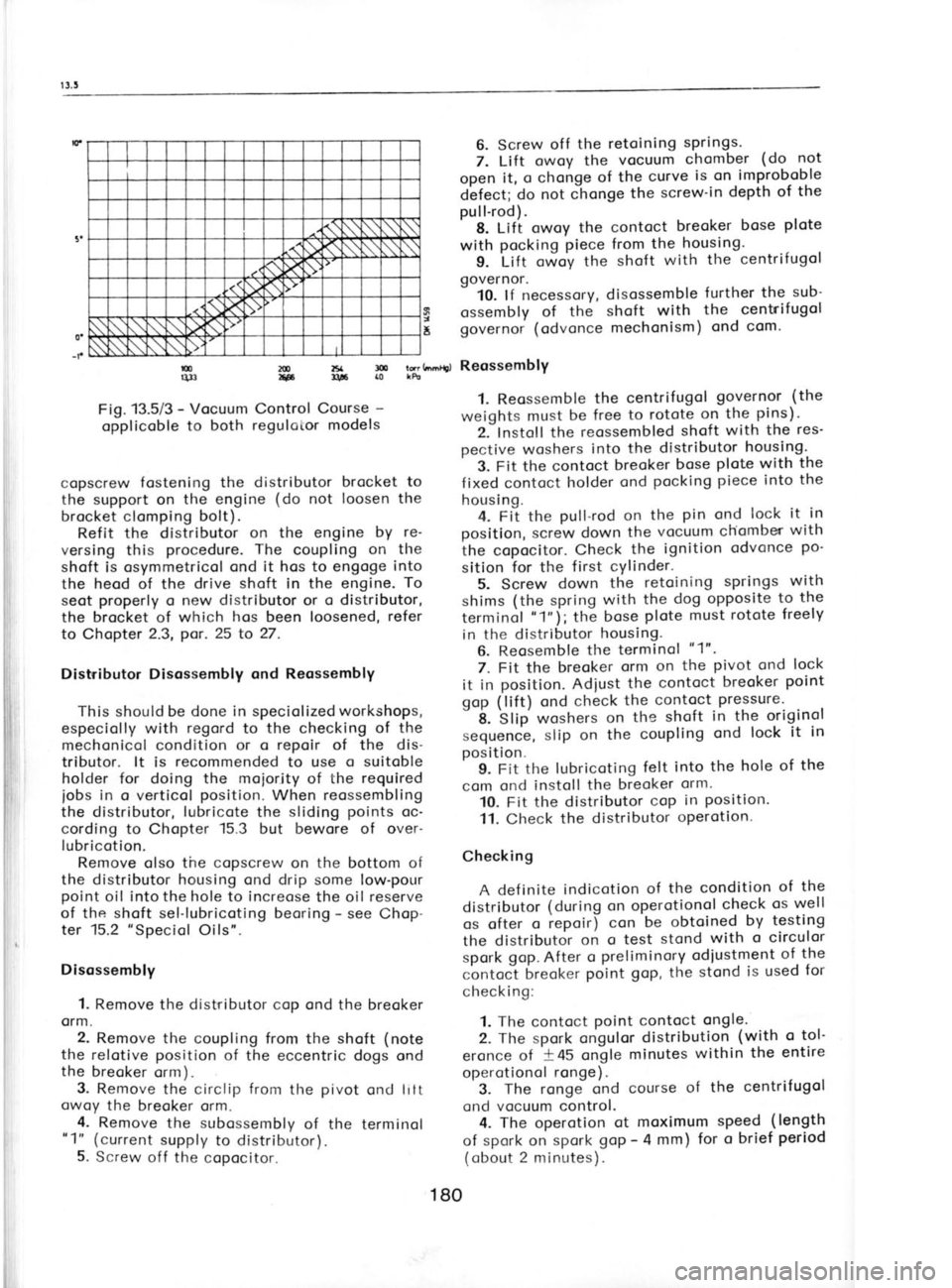
I
I
t
b
c ll
e
c
tl
d n
tN'
>
\'
J I
(Il
qt3
Fig. 13.5i3 -
Vocuum Control Course -
opplicoble to both
regulotor models
copscrew fostening the distributor brocket to
the support on the engine (do
not loosen the
brocket clomping bolt).
Refit the distributor on the engine by
re-
versing this procedure. The
coupling on
tlre
shoft is osymmetricol ond it hos to engoge into
the heod of the drive shoft in the engine. To
seot properly
o new distributor
or o distributor,
the brocket of which hos
been loosened, refer
to Chopter 2.3, por.25
to 27.
Distributor Disossembly ond Reossembly
This should be done in speciolizedworkshops,
especiolly with regord
to the checking of the
mechonicol condition or o repoir
of the dis-
tributor. lt is recommended
to use o suitoble
holder for doing the moiority of the required
iobs in
o verticol position.
When reossembling
the distributor, lubricote
the sliding points
oc-
cording to Chopter 15.3
but bewore of over-
lubricotion.
Remove olso the copscrew
on the bottom of
the distributor housing ond drip some low-pour
point oil into the hole to increose the oil reserve
of the shoft
sel-lubricoting beoring -
see Chop-
ter 15.2 "Speciol
Oils".
Disossembly 1. Remove the distributor cop ond the breoker
orm.
2. Remove the coupling from the shoft (note
the relotive position
of the eccentric dogs ond
the breoker
orm).
3. Remove
the circlip from
the pivot
ond litt
owoy the breoker orm.
4. Remove
the subossembly
of the terminol
"1" (current supply to distributor).
5. Screw off the copocitor. 6. Screw
off
the retoining springs.
7. Lilt owoy the vocuum chomber (do
19t
open it, o chonge of the curve is on.improboble
d'efect; do not chonge the screw-in depth
of the
pull-rod).
' 8. Lift owoy the contoct breoker
bose plote
with pocking piece from
the housing.
g. Litt owoy the shoft with the
centrifugol
governor. -
10. lf necessory, disossemble further
the sub'
ossembly of the shoft with the centrif
ugol
governor (odvonce mechonism) ond
com.
l?;h.',0, ReossemblY
1. Reossemble the centrifugol governor
(the
weights must be free
to rotote on the pins).
2. lnstoll the reossembled shoft
with the res'
pective woshers into
the distributor housing.
3. Fit the contoct breoker bose plote
with the
f ixed contoct holder ond pocking
piece into the
housing. 4. Fit the pull-rod on
the pin
ond lock it in
position, screw down the vocuum chiomber with
the copocitor. Check the
ignition odvonce po-
sition for the first cYlinder.
5. Screw down
the retoining springs
with
shims (the
spring with
the dog opposite to
the
terminol "1"i;
the bose plote must
rotote freely
in the distributor housing.
6. Reosemble the terminol "1".
7. Fit the breoker orm
on
the pivot
ond lock
it in position. Adiust the contoct breoker point
gop (lift) ond check the
contoct
Pressure'
"
if. 'Stip
woshers on
the shoft in
the originol
sequence, slip on the coupling ond
lock
it in
position^ 9. Fit the lubricoting felt
into the hole of
the
com ond instoll the breoker orm.
10. Fit the distributor cop
in position.
11. Check the distributor operotion.
Checking A def inite indicotion of the condition of
the
distributor (during on operotionol check
os
well
os ofter o
repoir) con be obtoined by testing
the distributor on
o test stond with
o circulor
spork gop.
After o preliminory
odiustment of
the
contoc-t breoker point gop,
the stond is
used for
check i ng:
1. The contoct point
contoct ongle.
2. The spork ongulor distribution (with o
tol-
eronce of -+45
ongle minutes within
the entire
operotionol ronge).
3. The rongJ ond course of the
centrifugol
ond vocuum control. 4. The
operotion ot
moximum speed (length
of spork on spork goP -
4 mm) for o
brief period
(obout 2 minutes).
180
t
5
2tD zsa !l!
F llti
rc